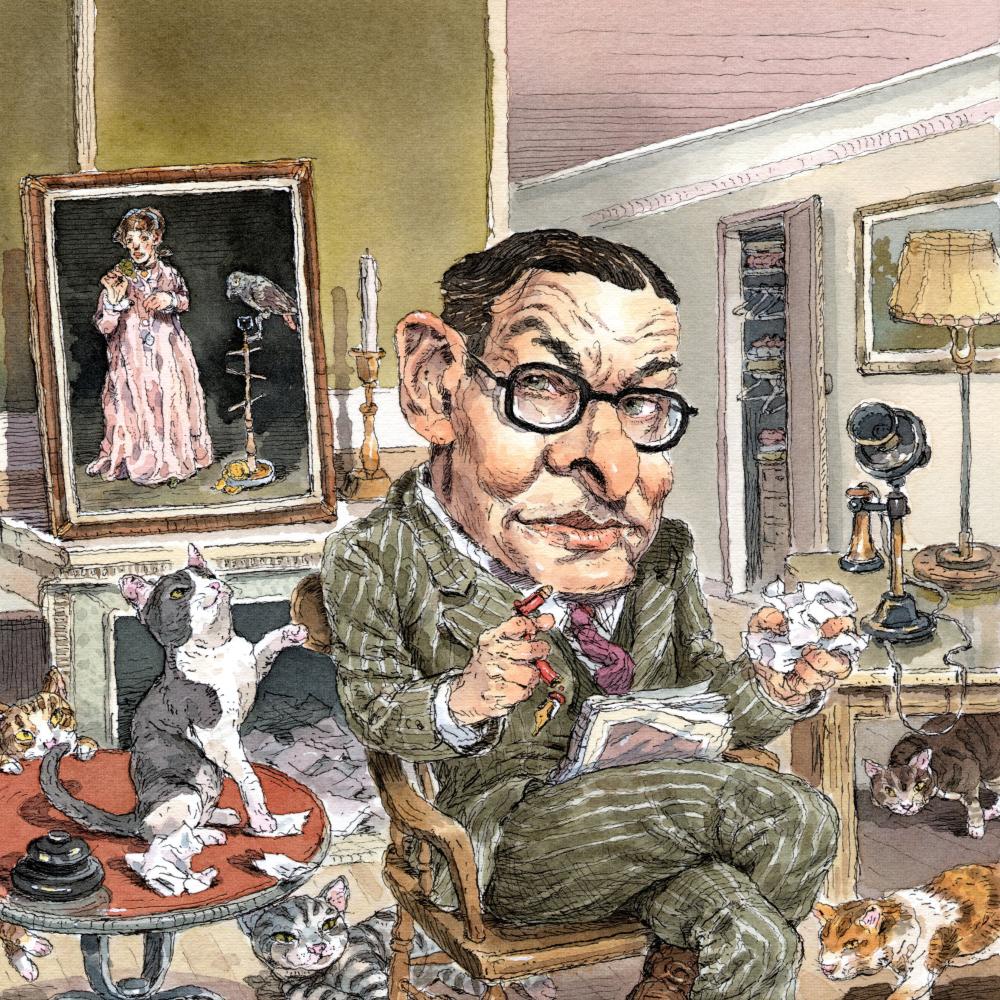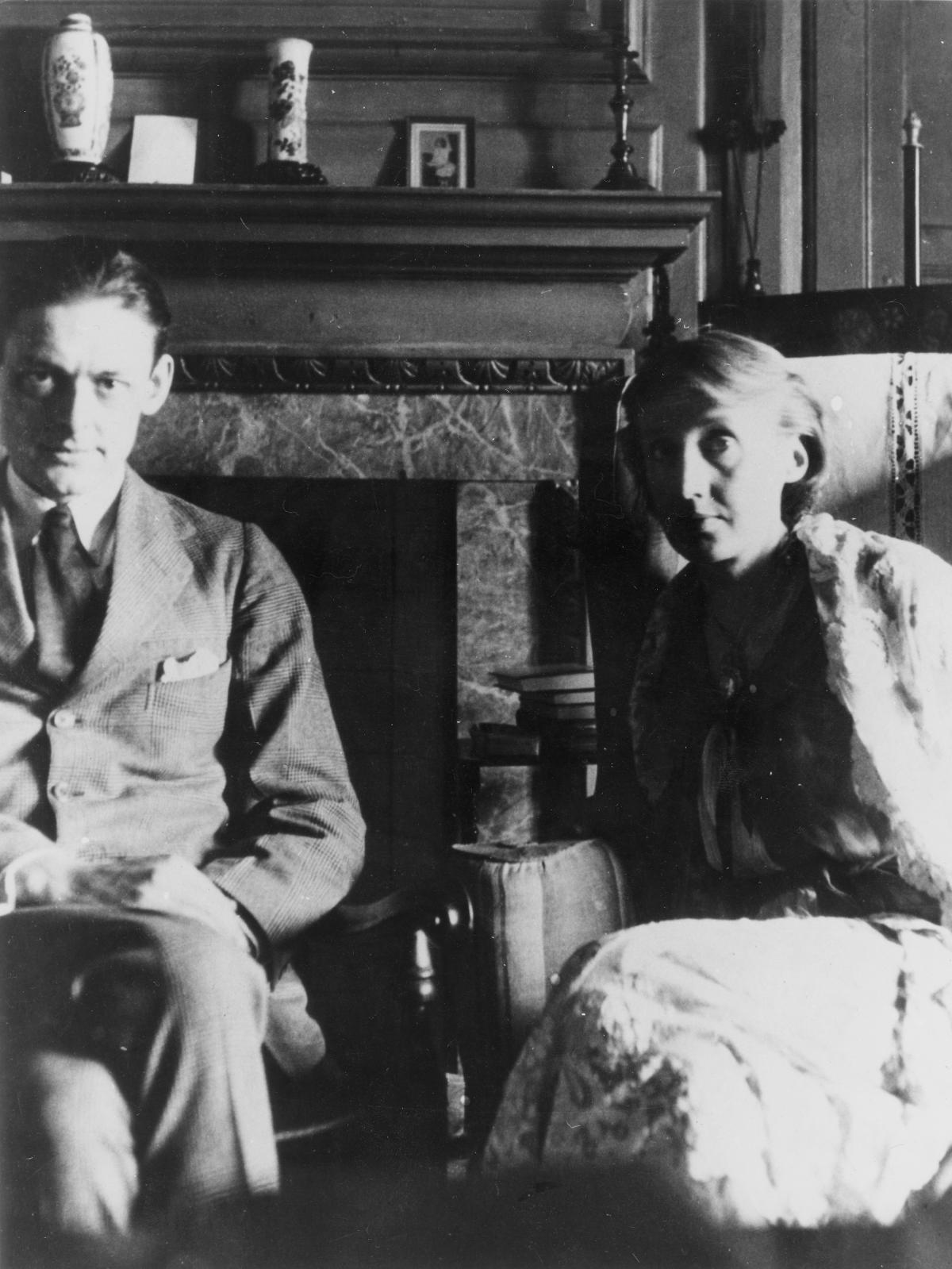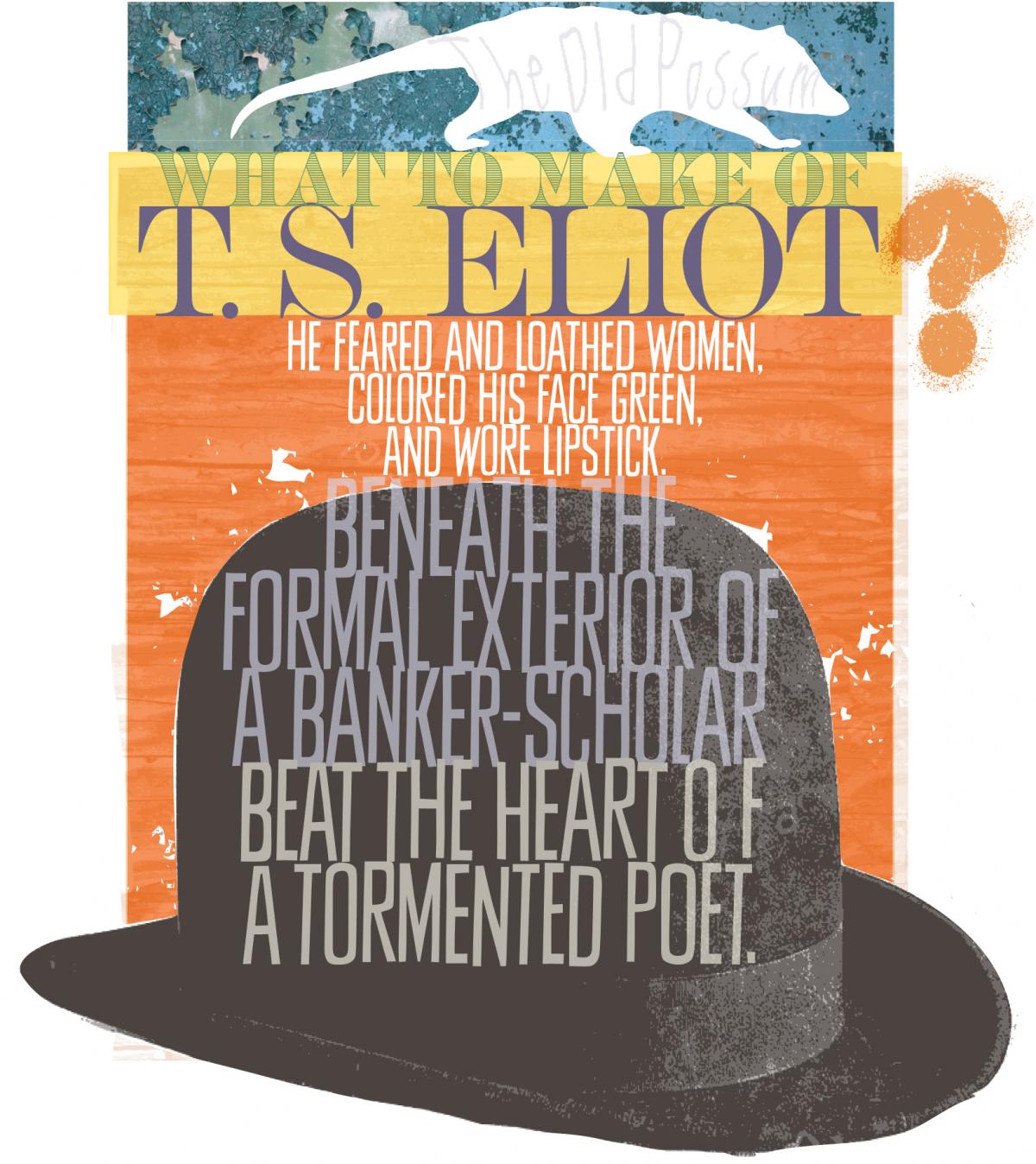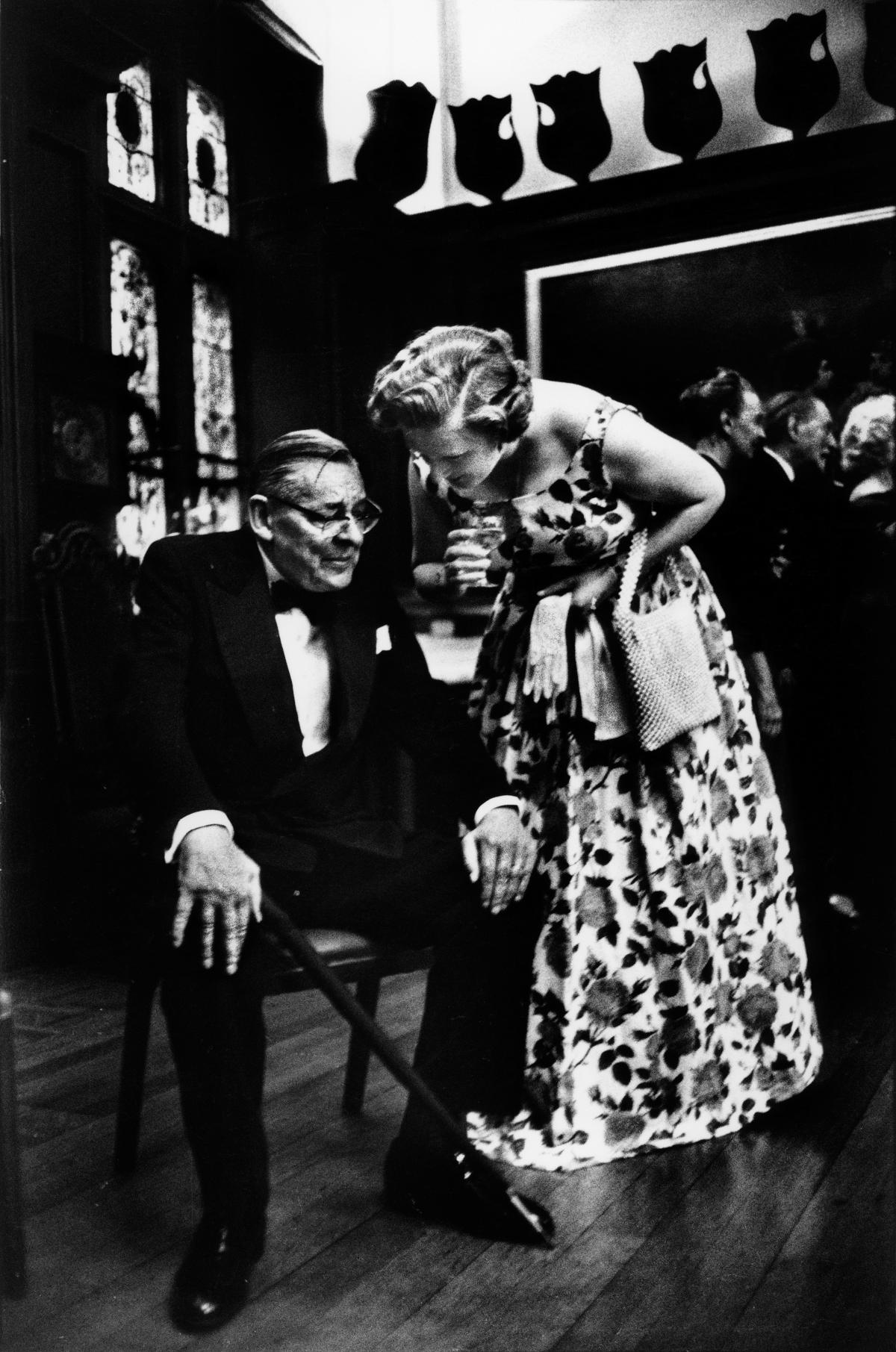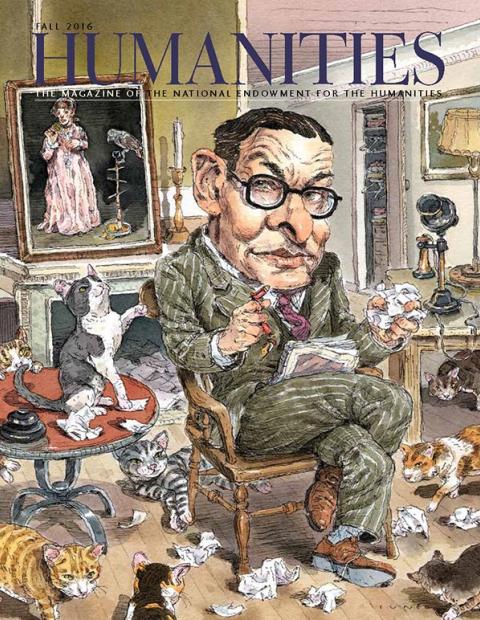In 1914, the philosopher Bertrand Russell was introduced to a student at Harvard University who greatly impressed him, and who would later become quite famous himself. Russell left behind his first impressions of T. S. Eliot in a letter that possibly inaugurated the now-standard fiction of the poet as representing a final, repressed branch of the old Boston Brahmans:
My pupil Eliot was there—the only one who is civilized, and he is ultra-civilized, knows his classics very well, is familiar with all French literature from Villon to Vildrach, and is altogether impeccable in his taste but has no vigour or life—or enthusiasm.
Eliot struck many of his contemporaries as a person not unlike J. Alfred Prufrock, “politic, cautious, and meticulous.” Virginia Woolf mentioned him in a letter to her brother-in-law: “Come to lunch. Eliot will be there in a four-piece suit.” With his fine manners and noble bearing, Eliot was all too restrained by his own sense of decorum and propriety. The novelist Aldous Huxley even called him “the most bank-clerky of all bank clerks” after visiting Eliot at his office at Lloyd’s in London, reporting that he “was not on the ground floor nor even on the floor under that, but in a sub-sub-basement sitting at a desk which was in a row of desks with other bank clerks.” Many years later, the poet was still fostering this bloodless caricature of himself, preferring to pretend that he was just “a mild-mannered man safely entrenched behind his typewriter.”
Not everyone believed the story as presented. As early as 1962, the critic Randall Jarrell saw in it a fundamental misunderstanding, which he singled out for an extraordinary comment in his summary of “Fifty Years of American Poetry”:
During the last thirty or forty years Eliot has been so much the most famous and influential of American poets that it seems almost absurd to write about him, especially when everybody else already has: when all of you can read me your own articles about Eliot, would it have really been worth while to write you mine? Yet actually the attitude of an age toward its Lord Byron—in this case, a sort of combination of Lord Byron and Dr. Johnson—is always surprisingly different from the attitude of the future. Won’t the future say to us in helpless astonishment: “But did you actually believe that all those things about objective correlatives, classicism, the tradition, applied to his poetry? Surely you must have seen that he was one of the most subjective and daemonic poets who ever lived, the victim and helpless beneficiary of his own inexorable compulsions, obsessions? From a psychoanalytic point of view he was far and away the most interesting poet of your century. But for you, of course, after the first few years, his poetry existed undersea, thousands of feet below the deluge of exegesis, explication, source-listing, scholarship, and criticism that overwhelmed it. And yet how bravely and personally it survived, its eyes neither coral nor mother-of-pearl but plainly human, full of human anguish!”
Today the task before any reader of Eliot’s poetry is to examine the human anguish still buried under the exegesis. That is no easy assignment. For the poet himself very much wanted that anguish, and the sources of it, to remain forever hidden. This concealment was monumentally important to him, and he labored ferociously at it throughout his life.
By 1938, Eliot had already directed his then literary executor John Hayward to “suppress everything suppressible,” and that attitude only hardened as time passed, sinking into absurdity when, in 1984, Eliot’s second wife dubiously claimed the copyright even to the papers of Eliot’s first wife. The poet had left behind a will demanding that no biography be written, ever. His estate did its best to comply and prevented anyone from quoting any copyrighted or unpublished material without exception, while it routinely requested exorbitant sums for his work to be reprinted in anthologies. It is hard to think of another writer in the last hundred years (other than J. D. Salinger or Thomas Pynchon) who went to such extraordinary lengths to frustrate not only biographers and scholars but even ordinary readers.
Thus it has taken fifty years for any evidence to surface that would justify Jarrell’s premonition that Eliot was more like the scandal-plagued Lord Byron than we could possibly imagine. Still, there were signs along the way, odd visual clues, for those who cared to notice. Virginia Woolf, vexed by the poet’s appearance in 1922, noted in her diary: “I am not sure that he does not paint his lips.” Meanwhile, Osbert Sitwell was “amazed to notice on his cheeks a dusting of green powder—pale but distinctly green, the colour of a forced lily-of-the-valley. I was all the more amazed at this discovery, because any deliberate dramatization of his appearance was so plainly out of keeping with his character, and with his desire never to call attention to himself.”
Let us halt for a moment and consider this image: Eliot, the austere banker with a bowler hat, was actually walking around London in the 1920s with his cheeks powdered green and his lips rouged. No wonder that his friends were astonished. Neither Sitwell nor Woolf “could find any way of explaining this extraordinary and fantastical pretence; except on the one basis that the great poet wished to stress his look of strain.” Others came to a different conclusion. Hart Crane was so certain that Eliot was a homosexual like himself that he referred to him, according to Allen Tate, as the “prime ram of our flock.”
None of these stories dented Eliot’s cadaverous image for thirty years. The first blow was struck in 1952, when an article in Essays in Criticism written by the scholar John Peter caused a famous scandal with its reading of “The Waste Land” as a homosexual lament for the poet’s dead friend, Jean Verdenal. Rather than ignore the essay, Eliot had his attorneys inform the journal’s editors that a libel suit was assured if the article appeared again. So seriously was this threat taken that most of the issues were swiftly destroyed; libraries were even told to cut out the article if they had a copy already. Naturally, other scholars were wary of pursuing similar theories until 1977 when James E. Miller Jr. (with the help of an NEH grant) published T. S. Eliot’s Personal Waste Land, and reignited a discussion that had been silenced 25 years before.
Miller’s book suffered a hostile reception, with numerous critics aghast at the author’s impertinence at forwarding such theories. By this time, of course, Eliot was dead, but in his later years he had become a cherished layman of the Church of England and a man of high moral stature. Simply put, Miller’s book was treated as blasphemy, when it wasn’t just ignored or mischaracterized. Expecting such reductive crudity, Miller denounced this tendency to distort his ideas in the early part of his book (“The language ‘homosexual interpretation’ seems deliberately designed to jar the sensibility and provoke negative vibrations”) and at the back of his book (“Such characterizations are not only reductive but destructive, not to say simple-minded”).
In spite of his protestations, Miller’s name became synonymous with this interpretation. As recently as 2006, the poet Mark Ford complained in a review that Miller was like “a McCarthy-inspired gumshoe” who just wanted to “persuade his readers that Eliot was gay.” Yet Miller was not interested in “outing” the poet; he was interested in understanding the verse of “the most subjective and daemonic poet” of the last century. Ultimately, the hostility of his fellow scholars conspired to do a disservice to Miller, and to his 1977 book—which is a neglected classic of criticism, and one of the very few essential works on Eliot’s poetry.
What Miller would have made of all the recently released Eliotica is a bittersweet thought, since he passed away in 2010. Valerie Eliot’s excruciatingly slow “editing” (which was actually deliberate delaying) of her husband’s letters came to an end with her death in 2012, after which three volumes appeared in three consecutive years. A sixth volume, appearing in 2016, gives us the poet’s correspondence through 1933, with a mere 32 years left to cover. That should give the reader a sense of how much Eliot we haven’t read, and how much we still don’t know.
Just consider his critical prose: Ronald Schuchard and his international team of scholars are halfway through publishing almost 7,000 pages of it in an online-only edition, sponsored by Johns Hopkins University Press (among many others). Or take the recent publication of the two-volume Poems of T. S. Eliot, edited by Christopher Ricks and Jim McCue, and weighing in at a combined 2,032 pages. Though Eliot himself issued his first Collected Poems in 1936, and the definitive-sounding Complete Poems and Plays appeared in 1952 (and let’s not forget the “Centenary Edition” published in 1963), it must be said that Ricks and McCue are the first editors who have been allowed to publish all the verse that Eliot left behind. That is to say that, at the fourth attempt, we have all of Eliot’s poetry together at last.
That burden, along with the desire of Ricks and McCue to edit every line a capite ad calcem, has resulted in a table-buster. Volume I of The Poems alone is a massive 1,311 pages—with 877 pages of commentary for 314 pages of poetry. All the verse that Eliot cared to collect in his lifetime, and that generations of poetry lovers have memorized, is finished by page 219. There remain almost 100 pages of uncollected verse for most readers to discover (much of it brought together previously by Ricks in his superb collection of Eliot’s early unpublished work, Inventions of the March Hare).
It must be said that Ricks and McCue provide superb notes throughout these volumes. On occasion the revelations are not just striking but comical. Take one example: The learned and fastidious Eliot that we think we know managed to misspell the title of his third book of poems, Ara Vos Prec, on the cover. (One of the 220 copies of Ara Vus Prec can trade for $10,000 on the rare book market.) Eliot explained in a letter, “It only happened to be Vus on the title page because I don’t know Provençal, and I was quoting from an Italian edition of Dante the editor of which apparently did not know Italian either.” That’s quite an admission from the Pope of Russell Square.
A more important mistake involves one of Eliot’s most famous poems, “The Hollow Men.” The last lines of section II (as published in 1962) have always read:
Not that final meeting
In the twilight kingdom
Yet it has been discovered that the section, as published originally in The Criterion and The Dial, ended: “With eyes I dare not meet in dreams.” Who made that mistake? Ultimately, it must have been the poet himself who missed it. Eliot was quite a careless copy editor, particularly when it came to his own work.
As for the uncollected verse, there are surprises in abundance for the reader who cares to puzzle his way through these poems. Eliot is renowned for being the first poet to express the world’s romantic horror and disenchantment with itself by writing The Waste Land in 1921. Less known perhaps is that he did so after fleeing his wife for a Lausanne sanitarium. It is therefore rather interesting that the same poet in 1909 stares at a reproduction of Manet’s La Dame au Perroquet in a book and remarks:
Among a crowd of tenuous dreams, unknown
To us of restless brain and weary feet,
Forever hurrying up and down the street,
She stands at evening in the room alone.
Not like a tranquil goddess carved of stone
But evanescent, as if one should meet
A pensive lamia in some wood-retreat,
An immaterial fancy of one’s own.
No meditations glad or ominous
Disturb her lips, or move the slender hands;
Her dark eyes keep their secrets hid from us,
Beyond the circle of our thought she stands.
[from “On a Portrait”]
Needless to say, few twenty-year-old men are moved to conjure this much gloom from the image of a fully covered woman standing next to her pet bird. Lest the reader pass over the lamia reference here, Ricks helpfully submits: “OED: a fabulous monster supposed to have the body of a woman, and to prey upon human beings and suck the blood of children.” It is quite remarkable that young Eliot is already turning innocuous women into fabulous monsters in the pages of the Harvard Advocate, already negating the passion of young lovers:
Tristan and Isolde
And the fatalistic horns
The passionate violins
And ominous clarinet;
And love torturing itself
To emotion for all there is in it,
Writhing in and out
Contorted in paroxysms,
Flinging itself at the last
Limits of self-expression.
We have the tragic? oh no!
Life departs with a feeble smile
Into the indifferent.
These emotional experiences
Do not hold good at all,
And I feel like the ghost of youth
At the undertakers’ ball.
[“Opera”]
One turns through these pages and finds the same themes again and again: the impotence of living and the fear of the female. It’s rather incredible in hindsight to see that only a few scholars even dared to discuss Eliot in such terms.
Not everyone was quite so blind. Thirty-one years before John Peter’s essay, Ezra Pound sent a letter to Eliot containing a comment-in-verse about his editing duties for The Waste Land:
These are the poems of Eliot
By the Uranian Muse begot;
A Man their Mother was,
A Muse their Sire.
How did the printed infancies result
From Nuptials thus doubly difficult?
If you must needs enquire
Know diligent Reader
That on each Occasion
Ezra performed the caesarian Operation.
(from “Sage Homme”)
It was James Miller who first noted in an essay that “Uranian” was a common term for same-sex love in the late nineteenth century. So, Pound seems to be acknowledging that the poem was authored by one man, after being inspired by another—the fruits of a homosexual union, if you will. But who was the “Muse their Sire?” And why is April “the cruellest month, breeding lilacs out of the dead land, mixing memory and desire?”
Eliot mentioned Verdenal only a few times in print—once in dedicating his first book of poems to his dead friend, and then in this comment from 1934 on his days as a student in Paris:
I am willing to admit that my own retrospect is touched by a sentimental sunset, the memory of a friend coming across the Luxembourg Gardens in the late afternoon, waving a branch of lilac, a friend who was later (so far as I could find out) to be mixed with the mud of Gallipoli.
The similarities between the opening lines of the poem and this short note are unmistakable, as Miller pointed out. Did Pound know anything about Verdenal? If he didn’t, he nevertheless was certain about the origins of Eliot’s most famous poem. It was Pound, after all, who revised The Waste Land so dramatically as to make some of its meanings opaque. With all the new papers available to us, such speculations would seem a happy hunting ground for future biographies.
There are quite a few poems for readers to discover here (those readers, at least, who missed the publication of Inventions of the March Hare as well as the infrequent discoveries of Eliot scholars) that are almost as fine as anything to be found in Eliot’s early published work, such as “Suite Clownesque,” “The Little Passion,” “The Death of the Duchess,” and “Ode.” This last one has an extraordinary note attached to it as well: Writing to his brother in 1920, the poet had decided not to send his third book, Ara Vos Prec, to his mother. “I have not sent this to Mother or told her about it. I thought of cutting out the page on which occurs a poem called Ode and sending the book as if there had been an error and an extra page put in. Will you read through the new poems and give your opinion. The Ode is not in the edition that Knopf is publishing, all the others are. And I suppose she will have to see that book.”
Clearly, Eliot felt that he was being too revealing, and was willing to take exceptional steps to hide something that could distress his last living parent.
So it is jarring, to say the least, after passing over some minor verse in his Practical Cats style (“The Jim Jum Bears”) and some dedications (“Inscriptions to Sir Geoffrey Faber on the occasion of his knighthood”) to alight on several love poems that Eliot, late in life, wrote for his second wife, Valerie.
My arm is round her naked body,
My hand is cupping her breast; her nipple
Pushes into the very centre of my palm
Which quivers with tenderness.
(from “Sleeping Together”)
It seems possible that Eliot experienced a radical transformation late in life, so much does this marital contentment seem not to be the work of his younger self. The man whom Randall Jarrell once described as capable of writing The Waste Land about the Garden of Eden has vanished. These few poems were culled from a private notebook that the poet gave to Valerie, and are the principal evidence for concluding that Eliot managed to overcome the torments that had made his first marriage so disastrous.
The second volume is a shorter affair, its 667 pages dominated by a “Textual History” of Eliot’s poems in their various drafts and published versions which runs to 359 pages. This history is impressively thorough, and studded with enough rare quotations from the poet to make it worth skimming: Eliot describing himself as “a person who destroys nothing and loses everything” is as much a surprise as finding out that the wealthy American poète maudit Harry Crosby had offered to buy the drafts of “The Love Song of J. Alfred Prufrock” in 1927.
The rest of the contents are a curious miscellany which includes Old Possum’s Book of Practical Cats and Eliot’s translation of St.-John Perse’s Anabase, followed by three sections: “Other Verses” (full of Eliot’s childhood efforts), Noctes Binanianae (light verses written among gentlemen whom Eliot regularly dined with), and “Improper Rhymes” (ribaldry mostly contained in Eliot’s letters to friends). None of these sections were ever intended for publication, but they provide a glimpse of the lighter side of Eliot’s personality, which most will find refreshing.
Certain priggish critics have wailed in print recently that they are shocked to find that Eliot could be bawdy (“I know a nice girl named Valeria / Who has a delicious posterior”). Furthermore, they cry that Eliot’s lines could be lewd and full of racial stereotypes (“King Bolo’s big black basstart Queen”).
If this sort of thing is truly shocking to you as well, dear reader, then I suggest that you delay your purchase of Volume II to avoid these 43 pages. (You should also avoid Aristophanes, Chaucer, Rabelais, late-night television, and the Internet.) For the rest of the world, any irreverence by Eliot may be welcome as an antidote to the embalmed reverence he preferred to hide behind.
There are also marvelous notes provided by Ricks and company to further smudge the cartoon, like the one where Ezra Pound tells Harriet Monroe in 1915: “If you think he lacks vigour merely because he happens to have portrayed Mr. Prufrock the unvigorous, vous vous trompez. His poem of Christopher Columbus is vigorous and male, not to say coarse.” Vous vous trompez—if said gently, it can mean “you are mistaken” but can translate to “you fool yourself.”
That’s going to be a common refrain among scholars for some time. With the printing of this edition of Eliot’s poems, alongside his Complete Prose in a gigantic 7,000-page edition online (Project MUSE) as well as the five volumes of his Letters available now, one might say that we are just getting to know the Old Possum properly.

